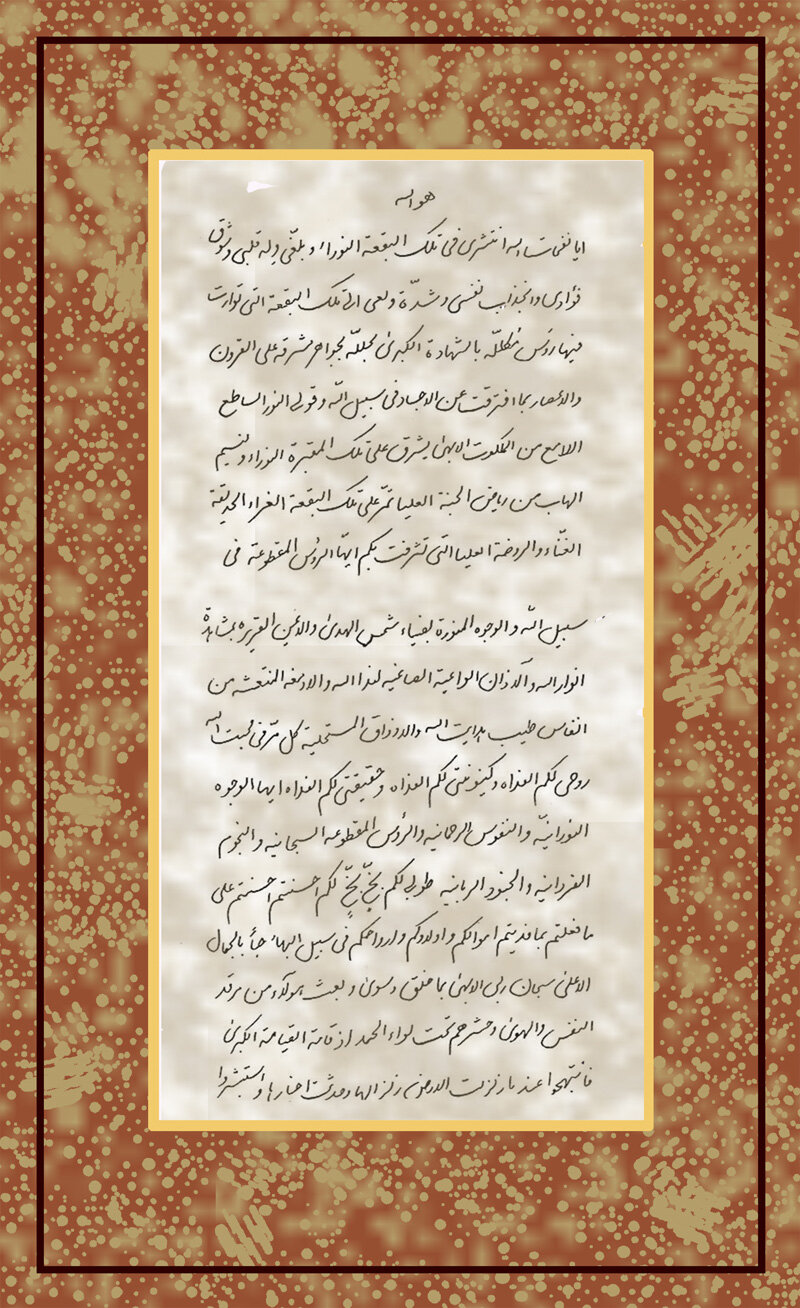One summer in 1956, Mahin Ahdieh, a Baha’i from Nayriz, took her young nephew for a trip from Abadan to Isfahan.
On the way, they stopped in the village of Sead Atabad, where the severed heads of the Babi martyrs of the conflict in Nayriz were buried. After the conflict and general massacre had ended, Babi prisoners and the remains of martyrs were being brought to Tihran. The court sent word it did not want the procession to come into the capitol as originally intended.
The locals insisted that the heads of these Babis not be buried among the Muslims. Open ground was found outside of town which ‘Abdu’l-Baha later blessed by naming it “The Garden of the Merciful,” and a proper wall and shrine were built and a garden planted to beautify the cemetery; these were destroyed following the 1979 revolution.
Tablet of Visitation for Abadih
The Bab’s arrival in Isfahan generated tremendous excitement. His many admirers among the common people rushed not the bath house after the Bab had visited it, to collect the water he had used, believing it to be imbued with healing powers.
The leading cleric of the city asked the Bab to write a commentary on the Súrih of Va’l-‘Asr, the 103rd chapter of the Qur’an. The Bab chanted the homily with which he prefaced His commentary. The hearers in the room, all important clerics, were overwhelmed with wonder at the power of these words and rose to kiss the hem of the garment of the Bab.
The Bab in Isfahan, Luke Slott
Shah Abbas made Isfahan the capitol of the Safavid dynasty in the late 16th century. In the center of the city he built one of largest squares in the world. The three pillars of power in his kingdom were represented there: the central mosque for the clergy, the palace for the king, and the bazaar for the merchants. At one end stood the blue minarets of the Jameh mosque with its seven-colored tiles and calligraphy. Today, it is a UNESCO World Heritage site.
Central mosque, Isfahan, © Ko Hon Chiu Vincent
After Isfahan, the travelers arrived in Gulpaygan, a town known for its artists and the hometown of the learned Baha’i, Mirza Abu Fadl. Abu Fadl first encountered the Baha’i Faith in Tihran where he met an illiterate Baha’i blacksmith who asked him a question: “Is it true that in the Traditions of Shi’ah Islam it is stated that each drop of rain is accompanied by an angel from heaven? And that this angel brings down the rain to the ground?” Abu Fazl agreed that this was true. The blacksmith followed up, “Is it true that if there is a dog in a house no angel will ever visit that house?” Again, Abu Fazl agreed. The blacksmith then concluded, “In that case no rain should ever fall in a house where a dog is kept.” Abu Fazl was ashamed at falling into such an easy logical trap; his companions told him that this blacksmith was a Baha’i.
This innocent incident set Abu Fazl on a course of serious inquiry about the faith. He went on to become an influential teacher of the Faith in Egypt and, at the request of ‘Abdu’l-Baha, in the United States. His important written works in defense of the faith are today the only books by a Baha’i from the early 20th century to remain in print, including his Baha’i Proofs.



